Raymarine e165, enough already?
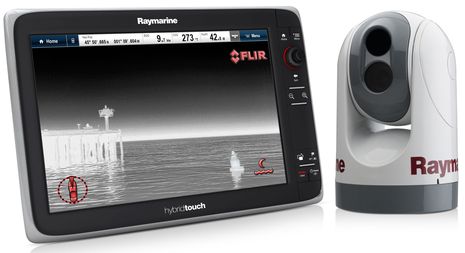
On Tuesday Raymarine announced the e165 and while a replacement for the 14-inch E Widescreen was predictable, it's pretty neat that they managed to get a 15.4-inch screen plus large second-generation "hybridtouch" controls into a svelte casing that can swap right into the helm panel hole currently occupied by an E Wide 14 (or a C Wide 14). That's 20% more screen area, and the LED backlighting is said to be wicked bright though the e165's maximum reported power draw is only 36 watts. And of course the e165 has the triple processing, WiFi, apps, Bluetooth, and new "Lighthouse" interface that seem to be drawing customers to the littler little "e" Series (breakdown of all four "e" sizes and seven models here). But I'm going to guess that many owners of E Wides -- which was a brand-new ground-breaking Series only just announced three years ago! -- are not happy to see them superseded. There is a dark side to Raymarine's meteoric resurgence...
Just contemplate what Raymarine has accomplished in the last year. The e7 and an entirely rebuilt MFD operating system were only announced in late July, 2011, which almost overshadowed the noteworthy i70 instrument (and the p70 AP head). By the time I got to start testing a real e7, Ray had already announced new 9 and 12-inch "e" and "c" models plus its CHIRP fishfinder. The able control, remote, and viewer apps got real in May, and in July Ray announced the all-touch a-Series. Holy cow! But when Ray touts the e165 as its "biggest and brightest display ever!" it makes me wonder about the still-existing G-Series with its two models of "ultra bright" 17-inch displays. Did refreshing the MFD lines also mean forgetting what went before?...
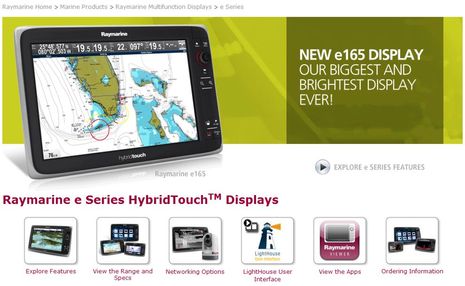
The answer to that in functional terms is complicated and hard to pin down. Well, actually it's a simple fact that the CP450C ClearPulse CHIRP Sonar won't work with anything but e- or c-Series MFDs, which may unpleasantly surprise boaters who just bought a Wide. But while I was a bit taken aback by the incompatibility warning addendum that came packaged with the e7, I had almost no trouble networking it via Ethernet and NMEA 2000 with the E Wide 14 on Gizmo, which having included sharing HD radar, DSM fishfinder, Navionics Platinum+ charts, and many sensors. Then again, I did need a special adapter cable in order to connect the e7's new style Ethernet port into the older style SeaTalkHS network. I like the new plug, but as best I can tell the $50 one-meter cable is the only size available and you're on your own if that doesn't get you where you need to go. (Ray's current SeaTalkHS page is unclear. {but -- a correction! -- it turns out that there are now all sorts of "RayNet" cables and adapters}) Which is all just the sort of things that get under the skin of pro and DIY installers alike...
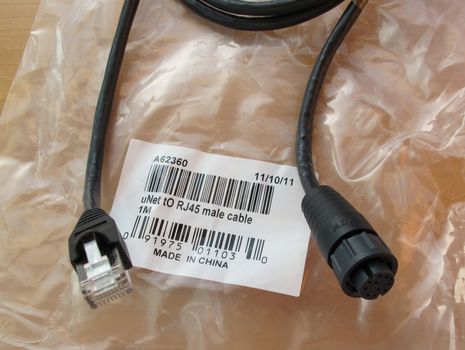
But yet then again Ray's efforts to make earlier SeaTalk sensors and instruments compatible with SeaTalkNG/NMEA 2000 networking -- mainly the little Converter tee (tested here) -- seem to work well, and the interchangeability between between STng and N2K cabling systems is better than ever (and was always better than many presumed). Ah, but on the other hand, I've heard several reports of networking issues with the previous generations of Raymarine STng MFDs and instruments, which may be a major reason they rebuilt the code from scratch but which does not leave previous customers with such problems any happier. (Note, though, that Ray has picked up the pace of software updates, including older gear, which is a good sign.)
At any rate, there's a certain amount of confusion and even downright resentment about Raymarine's many product generations out in the field, and we'll probably hear some examples in the comment section below! And I'd have to say that the E Wide Series does look like a false start in retrospect. But I also recall that when I first got my hands on one the bigger subject was whether the company would survive its financial problems. And that if it weren't for FLIR, Raymarine might now be a dwindling division of Garmin instead of being hell bent on outcompeting them...
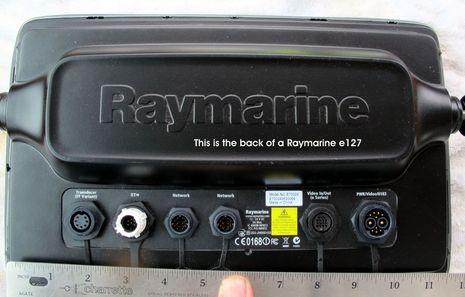
I know one boatyard that currently advises customers to "Please just get Garmin; it works and we know how to install it!"...but is that actually a good idea? I'm not questioning how well Garmin's gear works -- or Navico's or Furuno's, they all seem good these days -- but I do think it wise to judge Raymarine mainly for what they offer now, which looks pretty powerful. There may be a little blood on the tracks, but I suspect that the plug set you see on the back of the e127 above -- which is the same as the e165 except that the latter won't have a built-in fishfinder option (and doesn't contain its own GPS) -- won't change for a long time. And remember that the e-Series is purportedly 100% compatible with the a- and c-Series. And that there are two powerful connections you can't see, WiFi and Bluetooth. How neat would be if Ray used the latter to interface with the DeLorme inReach's two-way satellite connection? (Apparently there's talk at least.) But I've mouthed off enough; your turn, please!
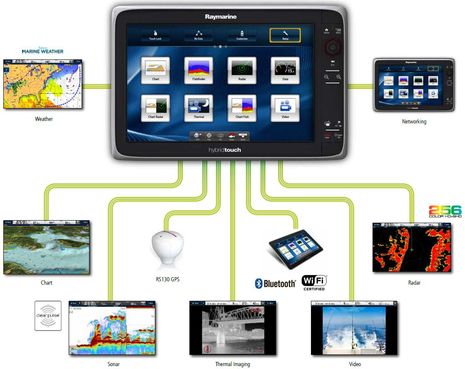

 Share
Share
Ben,
Options for longer Raynet to Seatalk HS cables were initially limited to the 1 meter length but are now available in 400mm, 1m, 3m, and 10m lenths.
http://www.defender.com/raymarine-seatalk.jsp#Raynet
John